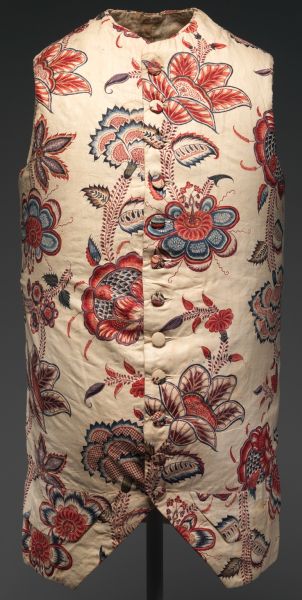
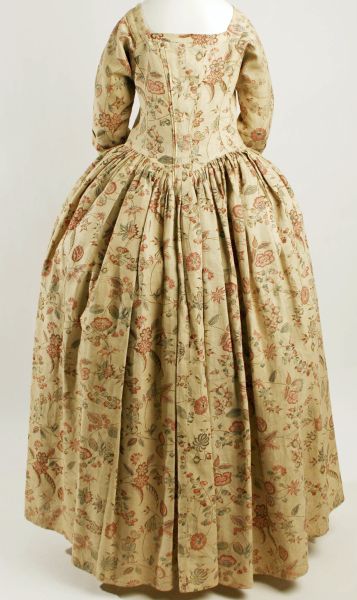
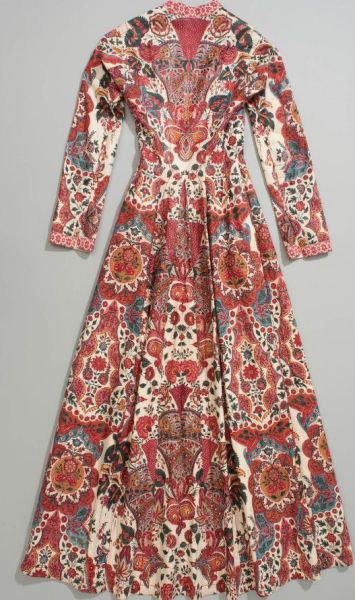
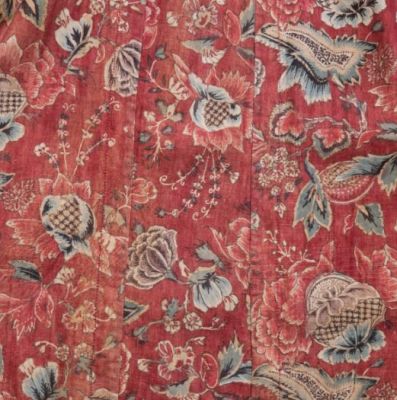
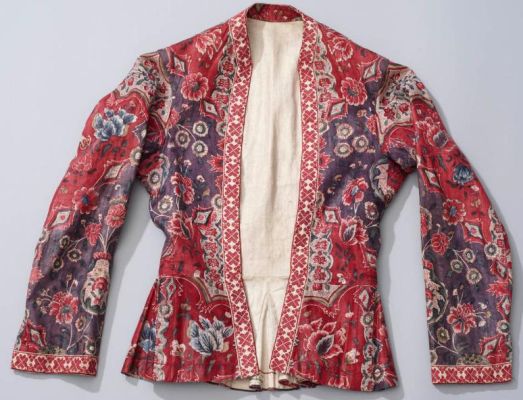
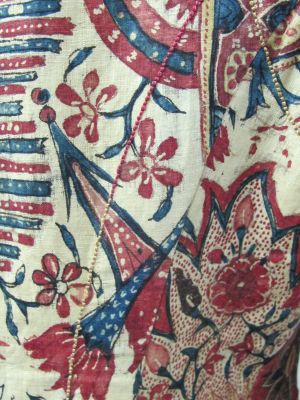
Nederlands Openluchtmuseum # HM.3467
Zitze wurden hauptsächlich mit Krapp gefärbt, der je nach Beize rot, rosa, orange, braun/schwarz oder violett ergibt. Die Beizen wurden zuerst aufgedruckt und der Stoff dann in den roten Farbsud getaucht. Weitere Farbtöne wurden durch ein Reserveverfahren erzielt: Alles, was bereits rot war oder weiß bleiben sollte, wurde mit Reservepapp abgedeckt und dann in eine Indigoküpe getaucht, so daß die nicht abgedeckten Partien blau wurden. Gelb wurde gewöhnlich zum Schluß von Hand aufgemalt bzw. über das Blau gemalt, um Grün zu ergeben. Das Gelb scheint oft verblaßt zu sein, so daß bei vielen Zitzen nur noch Rot und Blau zu sehen sind. Eventuell wurde es aber auch aus Kostengründen weggelassen. Video des Metropolitan Museum of Art über die Herstellung von Zitzen
Die häuftigste Hintergrundfarbe ist weiß/ecru, außerdem sind Rot und Blau, seltener Braun, Violett, Grün und ganz spät im Jahrhundert auch Schwarz nachgewiesen.
The main dyestuff for chintzes was madder, which yields, depending on the mordant, red, pink, orange, black/brown or purple. The mordants were printed ontothe fabric first, then it was immersed in the red dye bath. Blue was added with the restist method, i.e. everything that was already red(dish) or supposed to remain white was covered with a protective paste and then the fabic was dunked into an indigo vat so that the unprotected portions were dyed blue. For two different shades of blue, like for the waistcoat in picture #1, this process had to be done twice. Yellow was usually painted in by hand, some of it onto the blue to achieve green. The yellow may have faded in many cases, leaving only the red and blue, or maybe it was left out in the first place in some cases, to sve costs. Here's a Metmuseum video explaining the process in detail.
As for background colours, white/ecru is the most ubiquitous, followed by red and blue, less often brown, purple and green, and very late in the century, black.
 |
 |
 |
| Weste, um 1770-90, Metmuseum # 35.142 | Kleid, Mitte 18., Metmuseum # 38.26a | Wentke (niederländisches Überkleid), 2. Viertel 18., Nederlands Openluchtmuseum # K.153-72 |
| Waistcoat, c. 1770-90, Metmuseum # 35.142 | Dress, midcentury, Metmuseum # 38.26a | Wentke (Dutch overdress), 2nd quarter 18th, Nederlands Openluchtmuseum # K.153-72 |
 |
 |
 |
|
Nederlands Openluchtmuseum # HM.3467 |
Nederlands Openluchtmuseum # K.38.OV | Metmuseum # 2012.561 |